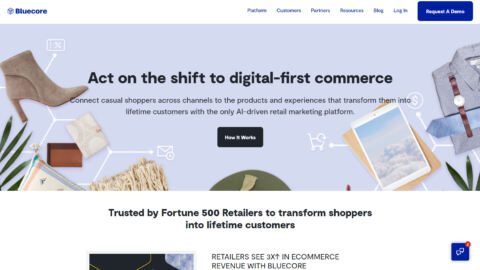Following is Part 2 of the Retail TouchPoints feature entitled: The Mobile-Influenced In-Store Experience. This section looks at how mobile RFID and mobile checkout influence the in-store customer journey. Part 1 appeared in the October 22 newsletter. Click here for a PDF version of the complete 2-part series.
Brick-and-mortar shopping looks more like an online experience every day. From pre-shopping research, geo apps and on-floor assistance to mobile RFID and checkout, mobility increasingly touches the in-store customer ― both directly and from the back room.
Mobile Behind The Scenes
Achieving meticulous store-level inventory continues to challenge retailers. In fact, data acquired by Aberdeen Group suggests that most retailers maintain an inventory accuracy of only about 60%, stated Kevin Permenter, Research Analyst for Aberdeen. “To combat this 40%error rate, many retailers are choosing RFID and mobile readers as a means of keeping accurate inventory of what is in the store and precisely where it can be found. The mobile readers help acquire quick and accurate inventory of backroom and retail floor assets.”
Merchants also are using mobile RFID as part of their intelligent loss prevention solutions. “We know that 14% of U.S. retailers now use RFID successfully to avert loss, and another 14% plan to add the technology within the next 12 to 24 months,” said Permenter. Kohls, Macy’s and JC Penney are among the retailers implementing back-end RFID, many with mobile enhancements.”
Moreover, as retailers continue to move toward more integrated shopping experiences, “item-level RFID and mobile devices will serve as a foundation to that movement,” Permenter added. “For example, some retailers are using RFID to embed multimedia information and other product-related information which can be seen at a kiosk or on the customer’s mobile device. Burberry, for instance, is using RFID to provide customers with a more complete item-level picture, including matching and coordinating pieces. The recently-opened New Balance flagship store in Boston uses RFID to embed product information that is available via mobile across the sales floor as well as via kiosk.”
RFID mobile printers and encoders help retailers effectively add or replace item-level tags anywhere in the store. Some units designed specifically for retail environments give users the ability to manage and create a unique number for each item, in addition to the static UPC. New, smaller-format printers are ideal for retailers in low-volume tagging environments. Real-time mobile printers used for creating price labels help reduce labor costs and improve accuracy for markdowns and other retail printing applications.
Retailers, typically cautious about technology spending, are now taking bold steps ― enabled by new technology developments in mobile, payment, in-store technologies, RFID and more, wrote Bill McBeath, Chief Research Officer for ChainLink Research, in an April 2013 blog: “RFID is a core foundation that unlocks item-level, context-aware intelligence and utility that is the basis for many of the changes we are undergoing in retail, such as self-checkout, location-based services, mobile shopping and promotions…asset tracking, store management/optimization, inventory management, loss prevention, and much more.” In his blog, McBeath pointed to American Apparel, JC Penney, Macy’s, Marks & Spencer and Walmart as examples of retailers “finally implementing item-level RFID in a big way.”
Checking Out With Mobile
As more in-store customers use mobile devices to enhance the shopping journey, retailers continue to increase user convenience with efficient new solutions, such as mobile POS. IHL Group reports that the mPOS market will surpass $2 billion in hardware/software sales during 2013. In addition, mobile payment transaction volume will expand to an estimated $58 billion by 2017, according to eMarketer: This trend is driven by consumers adopting mobile payments for a wider range of products and services.”
Implementations across larger retailers continue to move mobile checkout into the forefront. For example, Walmart continues to roll out the “Scan & Go” mobile payment and self-checkout application: “Using Scan & Go, now available in select stores, our customers can scan an item before adding it to their physical shopping carts and quickly go though the self-checkout process,” said Ravi Raj, VP of Mobile for Walmart. “If the products they are looking for are not available in the store, they can use their mobile devices to search for the items online, and if available, buy them directly via that device from Walmart.com.”
Scan & Go, available only on iPhone and Android devices, also helps customers budget shopping trips by keeping a running total of the items in their carts. When finished shopping and at the self-checkout register, Scan & Go users simply select the “Transfer Your Mobile Basket” button on the register screen, and the “Done Shopping” button on their phones or tablets. Once the mobile camera activates, a user scans the QR code displayed on the register screen, or inputs the PIN code, to transfer items from the mobile device to register. When the “Finish and Pay” button is selected on the register screen, the transaction is completed.
Smaller retailers also are leveraging mPOS with expanded mobile transaction applications. At Sebastians, a five-location, Boston-based café, implemented a tablet and scanner connected to existing POS allows the eatery to accept transactions from a branded payment and loyalty app. The implementation has increased visit frequency, average sales and total revenue across locations, according to Mike Conley, Director of Marketing for Sebastians, in a Retail TouchPoints article.
The mobile initiative at Sebastians “far exceeded our expectations,” Conley stated. “Not only do customers using the Sebastians app visit us 30% more often than customers who don’t use it, they also spend an average of 7% more per visit. As a result, we’ve seen a 17% increase in total revenues.”
Consumers have embraced mobile technology, Conley reported, so it’s important that retailers respond appropriately: “With mobile payments still in its infancy, many retailers are waiting [for the solution] to become mainstream before developing an app. But the wait-and-see approach will never put you ahead of the curve. Sure, mobile payments may never make it to mainstream, but that’s the risk you run with any new consumer-facing technology. The way I see it, the potential benefits outweigh the potential costs, so why not give mobile payments a try?”
Mobile receipt printers ― some offering preprinted logos, return and exchange policies. QR codes and other information ― expand service for those mobile customers desiring a physical receipt. Some units also offer preprinted standard fields that reduce printer workload and extend battery life.
Leaving The Store
When the in-store experience concludes, many shoppers rate and review their experiences across Facebook, Twitter, store forums, picture-sharing sites and other social and web portals. Then the cycle starts again: 90% of mobile-equipped customers will use their devices for pre-shopping activities, as previously reported in this article.
As mobile-influenced in-store shopping continues to resemble an online experience, brick-and-mortar retailers will persevere with mobile deployments that deliver both customer-facing and backroom enhancements.
At Walmart, “we will continue to focus on developing mobile features and capabilities that further augment our customers’ in-store shopping experiences,” said Raj. “We know that mobile devices cannot replace people, but we believe a highly personalized experience for our customers and the right information at the fingertips of our associates can redefine shopping.”
Complete the form below to download this report:












